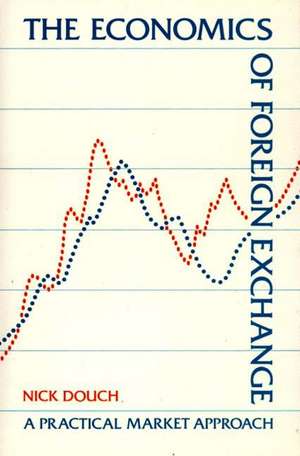The Economics of Foreign Exchange
Autor Nick Douchen Limba Engleză Hardback – 30 iun 1989
A pioneering exploration of the relevance of economic theory to the practical realities of the foreign exchange market, this volume presents a well-reasoned, comprehensive examination of the degree to which economic theories and forecasts are helpful in predicting exchange rates. Douch, an economist who has worked closely with the foreign exchange market, argues that theoretical economic models have exhibited some serious inadequacies in forecasting the future. In an attempt to determine the real predictive value of economic theory in this context, Douch examines each of the different economic approaches in-depth and then analyzes the actual workings of the foreign exchange market from the perspective of the market participants. Particular emphasis is placed upon the reasons for the observed failure of economic theory to reliably predict exchange rate movements over time.
Divided into three major sections, the book begins with five chapters that describe and evaluate the different economic approaches to explaining exchange rate movements. The next two chapters link the theories of the first section with the practical realities of the third by discussing the advantages of fixed and floating exchange rates and presenting a brief history of exchange rate regimes since World War II. In the final section, Douch first looks at how the spot and forward exchange rate markets actually work by examining the motives of market participants. Subsequent chapters explore such issues as whether Game Theory might be used to explain market actions, the effect of new foreign exchange hedging instruments on the market, and the contribution of Chart Analysis to exchange rate forecasts. A detailed appendix defines various economic indicators and seeks to explain how the market might react to them and why. Advanced students of economics as well as foreign exchange market participants with little economic training will find here important new insights into when economic theories can be helpful in predicting exchange rates--and, even more importantly, when they can not.
Preț: 435.65 lei
Preț vechi: 706.53 lei
-38% Nou
83.37€ • 86.51$ • 69.68£
Carte tipărită la comandă
Livrare economică 18 martie-01 aprilie
Specificații
ISBN-10: 0899304990
Pagini: 233
Dimensiuni: 148 x 236 x 17 mm
Greutate: 0.4 kg
Editura: Quorum Books
Descriere
Divided into three major sections, the book begins with five chapters that describe and evaluate the different economic approaches to explaining exchange rate movements. The next two chapters link the theories of the first section with the practical realities of the third by discussing the advantages of fixed and floating exchange rates and presenting a brief history of exchange rate regimes since World War II. In the final section, Douch first looks at how the spot and forward exchange rate markets actually work by examining the motives of market participants. Subsequent chapters explore such issues as whether Game Theory might be used to explain market actions, the effect of new foreign exchange hedging instruments on the market, and the contribution of Chart Analysis to exchange rate forecasts. A detailed appendix defines various economic indicators and seeks to explain how the market might react to them and why. Advanced students of economics as well as foreign exchange market participants with little economic training will find here important new insights into when economic theories can be helpful in predicting exchange rates--and, even more importantly, when they can not.











